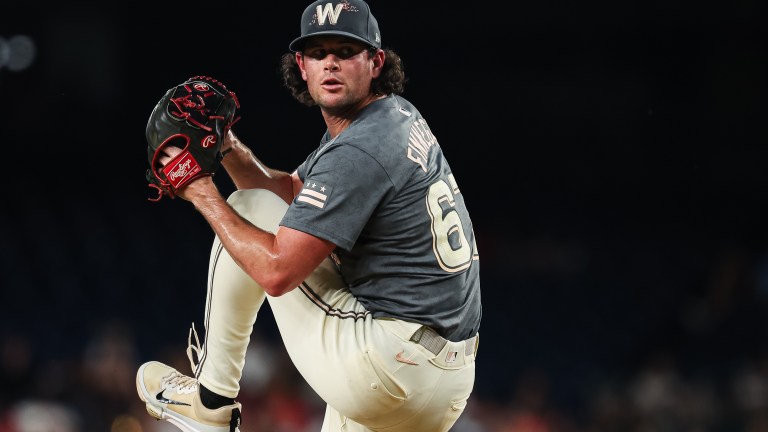Why Kyle Finnegan Has the Best Value on the Relief Market
There are multiple high-leverage relief arms on the trade market, and Nationals closer Kyle Finnegan might be the most valuable of them all.

Every year there are a plethora of relievers available on the trade market and countless teams looking to bolster the back-end of their bullpen in hopes of making a deep postseason run.
And the importance of a good bullpen seems key to making a postseason caliber team, with 12 of the 15 top bullpens in team fWAR in 2024 sitting in a postseason spot or well within the postseason hunt, according to Fangraphs.
And there are plenty of teams within that group of 12 that could use an extra boost to their bullpen, as well as multiple contending teams who fall in the bottom half of the league’s bullpens that will need the help when it comes to accounting for later innings of postseason games.
There’s numerous closers on teams outside of the postseason picture who can fill those back-end bullpen needs of contenders at a reasonable price.
Names like Tanner Scott of the Miami Marlins, Carlos Estevez of the Los Angeles Angels or Kirby Yates of the Texas Rangers come to mind.
But the most valuable arm in similar circumstances to Scott, Estevez and Yates might very well be the anchor of the Washington Nationals bullpen, Kyle Finnegan.
All stats in this article were taken prior to games on July 19.
What Gives Kyle Finnegan His Value on the Market?
This season Finnegan has held solid value for the Nationals and has been one of the contributing factors to why they rank in the top half of league in both fWAR (seventh at 3.0) and FIP (12th at 3.80) as a collective bullpen unit.
As Washington’s closer in 2024, Finnegan has pitched his way to a 2.45 ERA, a 1.02 WHIP, with 25 saves across 40.1 innings pitched. An overall solid stat line.
Now how does this stack up against the other relievers on teams either firmly out of, or currently falling out of postseason contention?
Finnegan seems to be bested by at least one of the other relievers in multiple major statistical categories.
Where he does have the edge over all of them though is saves, as his 25 saves ranks eight higher than the next of the four affordable closers, Estevez.
That being said, all four of these names are in the midst of exceptional seasons so far in 2024.
| Name | Team | Age | Saves | ERA | WHIP | K/9 | BB/9 | fWAR |
| Kyle Finnegan | WSH | 32 | 25 | 2.45 | 1.02 | 9.37 | 2.90 | 0.2 |
| Kirby Yates | TEX | 37 | 16 | 1.05 | 0.90 | 12.06 | 4.19 | 1.3 |
| Tanner Scott | MIA | 29 | 14 | 1.34 | 1.07 | 10.04 | 5.58 | 0.6 |
| Carlos Estevez | LAA | 31 | 17 | 2.61 | 0.77 | 9.00 | 1.16 | 0.9 |
While Finnegan may not have the ERA or fWAR of Yates, he’s five years younger than him, with eight more saves and walks 1.29 less batters per nine innings than him.
Scott is three years younger than Finnegan and has him beat handily so far in the ERA department, while also surpassing him in strikeout rate and fWAR. But Finnegan bests Scott in saves, WHIP and walk rate.
Lastly, Estevez is a year younger than Finnegan, and has posted a better fWAR, WHIP and walk rate. But Finnegan has outdone him in saves, ERA and strikeout rate.
All this is to say that each of these four closers carries unique statistical upsides that will be desired by buying teams at the deadline.
But the question is not who’s the better reliever in 2024, it’s who’s the most valuable reliever on this year’s market?
In this case it has to be Finnegan for one key reason, out of all these four reliever trade chips, Finnegan is the only one that has an extra year of team control for 2025.
With that extra year of team control under his belt, a contending team can add a closing caliber reliever for not only a postseason push this year, but also a run next year.
And with the volatility that can often come with relievers, adding a consistently solid performer like Finnegan, who’s in the midst of a career year as well, would be a real benefit to many postseason caliber teams.
| Year | IP | ERA | WHIP | Saves | K/9 | BB/9 |
| 2020 | 24.2 | 2.92 | 1.38 | 0 | 9.85 | 4.74 |
| 2021 | 66.0 | 3.55 | 1.48 | 11 | 9.27 | 4.64 |
| 2022 | 66.2 | 3.51 | 1.14 | 11 | 9.45 | 2.97 |
| 2023 | 69.1 | 3.76 | 1.30 | 28 | 8.18 | 3.12 |
| 2024 | 40.1 | 2.45 | 1.02 | 25 | 9.37 | 2.90 |
This is especially the case for team bullpens ranking in the bottom half of the league this season.
There are currently eight teams in a postseason position or within four games of one, who rank in the lower half of the league in reliever fWAR.
| Team | fWAR | Rank |
| San Francisco Giants | 1.7 | 17th |
| Seattle Mariners | 1.7 | 18th |
| New York Yankees | 1.5 | 19th |
| Houston Astros | 1.5 | 20th |
| Kansas City Royals | 1.2 | 21st |
| New York Mets | 1.2 | 22nd |
| Chicago Cubs | 1.0 | 23rd |
| Arizona Diamondbacks | 0.0 | 27th |
The thought of finding help that is still under team control has already proved to be selling point early in this trade season after the Royals acquired Finnegan’s now former teammate, Hunter Harvey on July 13, who is also still under team control in 2025 as well.
Not only did the Royals receive great lasting value in Harvey, as they continue to grow into perennial postseason contenders, the value goes both ways, as the Nationals got great value in return.
The Royals sent them a 2022 second round draft pick INF Cayden Wallace, along with a competitive balance pick in 2024, the 39th overall pick, which they used to draft catcher Caleb Lomavita, the 21st ranked prospect in this year’s draft according to Just Baseball.
And the argument could be made that Finnegan is having a better year than Harvey, and as the Nationals primary closer is certainly receiving the higher leverage outings.
| Name | Age | Saves | ERA | WHIP | K/9 | BB/9 |
| Kyle Finnegan | 32 | 25 | 2.45 | 1.02 | 9.37 | 2.90 |
| Hunter Harvey | 29 | 0 | 4.20 | 1.22 | 10.00 | 2.40 |
Now I’m not saying that Kyle Finnegan holds the same value as the most coveted reliever potentially on the market in Oakland Athletics closer Mason Miller.
Miller is in his own unique category, as he’s only in the first season of his pre-arbitration years, so he still has five-and-a-half years of team control remaining, while simultaneously performing as arguably the best closer in baseball right now.
And there’s a realistic possibility that A’s opt to keep Miller given his extensive team control.
So when it comes to the rest of the reliever market, the more realistic reliever market, it’s hard to argue that Kyle Finnegan, an established closer with a year-and-a-half of team control remaining, won’t be the most valuable bullpen arm at this year’s trade deadline.
